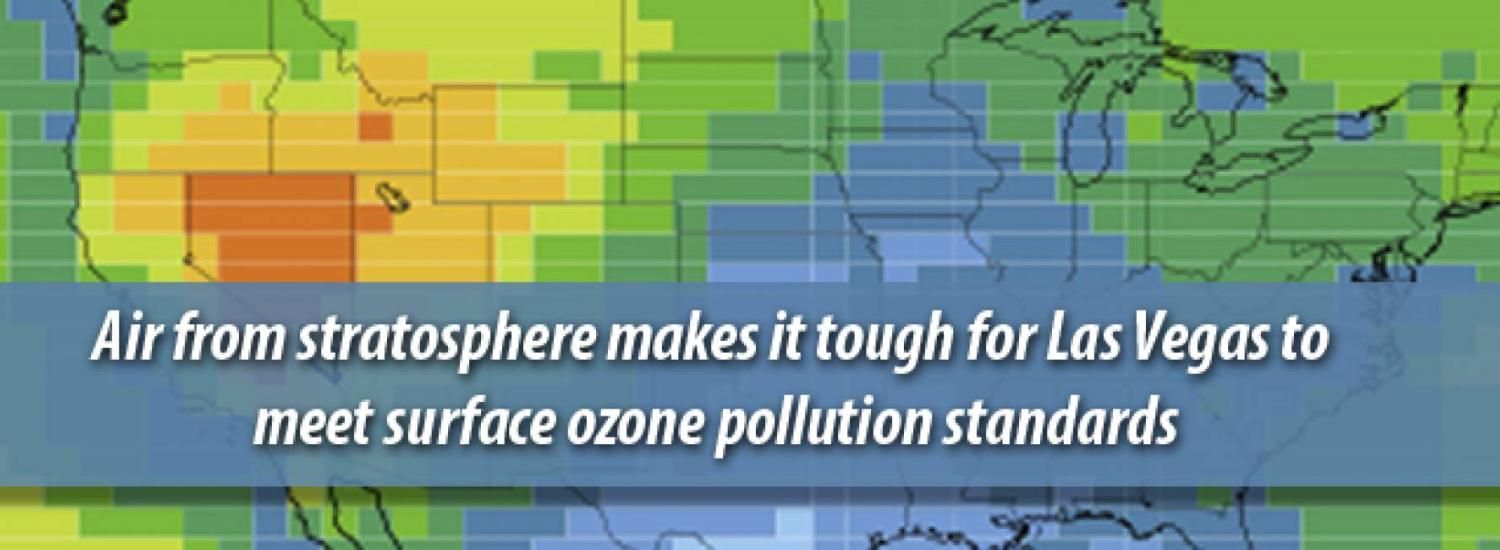Air from stratosphere makes it tough for Las Vegas to meet surface ozone pollution standards

In Las Vegas, air from the naturally ozone-rich stratosphere is sometimes an unwelcome intruder, making it difficult for the region to meet the national ground-level ozone standards in the springtime, according to a new NOAA-led study published online this month in the journal Atmospheric Environment.
“We found that the ozone coming down from the stratosphere is pushing the Clark County area up to and even over the limit,” said Andrew Langford, a research chemist at NOAA’s Earth System Research Laboratories in Boulder, Colorado, and lead author of the new study. “Our finding means that the region would be especially hard pressed to meet the even tougher ozone pollution limits now being considered,” said Langford.
The stratosphere is a region 8-30 miles above Earth that contains over 90 percent of the atmosphere’s ozone. It’s this ozone layer that’s the “good ozone,” filtering harmful ultraviolet radiation from the Sun. But lower down, at Earth’s surface, ozone is a pollutant that’s harmful to human health and other living things.
Areas at higher elevations, particularly in the intermountain western United States, are especially prone to atmospheric events called stratospheric intrusions that bring air from the stratosphere down to Earth’s surface. With background levels of surface ozone gradually rising over the last few decades due to increases in human emissions of pollutants, the “extra” ozone that comes occasionally from the stratosphere now pushes some areas over the ozone standard.
"For air quality managers in Clark County, Nevada, these results explain why they’ve frequently seen ozone values that exceed the national air quality standard in springtime—well before the midsummer peak expected for ozone formed as a result of local pollution. This new study will help them identify when they are being affected by natural events beyond their control."
In different regions of the United States, different factors contribute to elevated ozone levels. In some places, oil and gas activities can release very high levels of chemicals that react to form ozone. In other places, the precursors of ozone sweep in on winds from distant locations, even Asia. This study shows that in the Las Vegas region, at least in the springtime, the stratosphere is the source of some of the ozone at ground level. “Pollution from Los Angeles or Asia, wildfires, and local production are smaller factors,” said Langford.
Researchers used models to analyze the observations they gathered during a roughly 6-week period from May to June 2013, in NOAA’s Las Vegas Ozone Study. A lidar (light detection and ranging) instrument, a remote sensing method, measured ozone from the Earth’s surface to about 1.5 miles overhead, and other instruments measured gases and meteorological parameters at a mountain site about 30 miles northwest of Las Vegas.
“The stratospheric intrusions added at least 30 ppb of ozone in some of the high-ozone events we observed,” said Christoph Senff, a scientist with NOAA’s Cooperative Institute for Research in Environmental Sciences (CIRES) at the University of Colorado Boulder, who analyzed the lidar observations from the study. “With the normal ‘background’ level of ozone usually at 50-60 ppb, this meant that ozone frequently pushed above 80 ppb."
If the current 8-hour ozone standard of 75 parts per billion (ppb) were lowered to 65 parts per billion, as the Environmental Protection Agency (EPA) is considering, the researchers estimate that the Las Vegas region and other high-elevation sites in the Intermountain West would likely exceed the air quality standard over half of springtime days.
The study’s findings have implications for air quality management in the U.S. Previous studies have shown that several areas of the western U.S. receive pollution from sources that are beyond local control strategies, with some sources—such as transport from Asia and wildfires—on the rise and likely to increase further in the future.
“Our work shows that not only do air quality managers have to contend with pollution coming from across the continent or across the ocean; they also have to consider what’s coming down from far above their heads,” said Langford.
##
CIRES is a partnership of NOAA and CU Boulder.
Authors of "An overview of the 2013 Las Vegas Transport Study (LVOS): Impact of stratospheric intrusions and long-range transport on surface air quality" include 12 scientists from NOAA’s Earth System Research Laboratories; CIRES; the Laboratoire de l'Atmosphere et des Cyclones; Princeton University; NOAA’s Geophysical Fluid Dynamics Laboratory; and the NOAA/NESDIS Center for Satellite Applications and Research, Cooperative Institute for Meteorological Satellite Studies.
Graphic:
A high-resolution image is available for download on CIRES' Flickr account, News Release album.